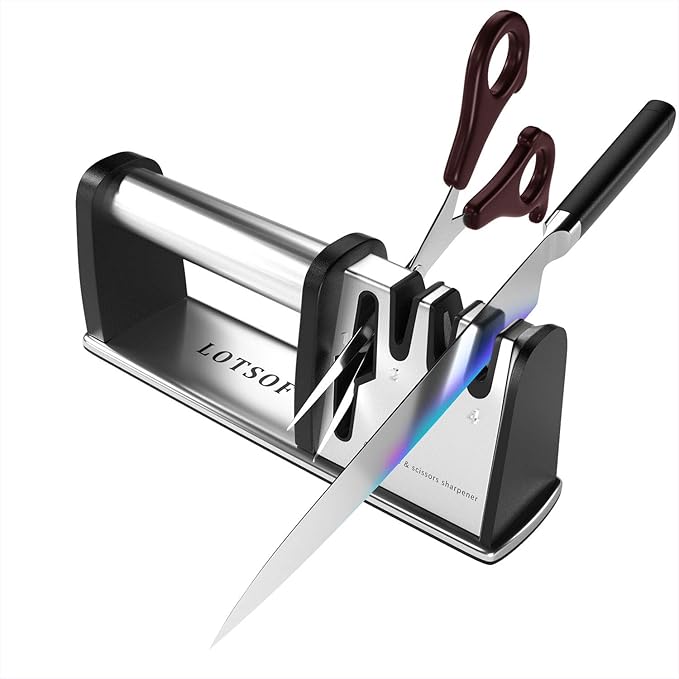The Importance of a Razor-Sharp Hunting Knife
A dull hunting knife isn’t just inconvenient; it’s dangerous. A clean, precise cut is crucial for field dressing game quickly and efficiently, minimizing stress on the animal and ensuring a safer, more sanitary process. A sharp knife also makes the entire hunting experience more enjoyable, reducing effort and frustration. But even the best hunting knife will eventually dull, which is where a quality sharpener comes into play. This comprehensive guide will walk you through the top hunting knife sharpeners for the 2024 season, helping you choose the perfect tool for your needs and skill level.
Types of Hunting Knife Sharpeners: Finding Your Perfect Match
The market offers a dizzying array of knife sharpeners, each with its own strengths and weaknesses. Let’s break down the most popular types:
1. Pull-Through Sharpeners: The Convenient Choice
Pull-through sharpeners are the easiest to use. Simply draw your knife blade through the pre-set slots. They’re great for beginners or hunters who want a quick and easy sharpening solution. However, they often don’t provide the level of control or precision offered by other methods. Look for models with multiple stages for coarse and fine sharpening.
2. Electric Sharpeners: Speed and Consistency
Electric sharpeners use motorized wheels or belts to quickly sharpen your knife. They offer consistent results and are ideal for those who frequently sharpen multiple knives. The downside? They can be more expensive than manual options and may require a bit of a learning curve to achieve optimal results. Check the speed settings and the types of blades they accommodate.
3. Handheld Sharpeners: The Control Freak’s Delight
Handheld sharpeners, like those featuring ceramic rods or sharpening stones, offer the most control over the sharpening process. They allow you to precisely adjust the angle and pressure, leading to a superior edge. However, they require more skill and practice to master. Consider the material (ceramic, steel, diamond) and the size and shape of the sharpening surface.
4. Sharpening Stones: The Traditional Approach
Sharpening stones, often made of natural or synthetic materials like water stones or diamond stones, represent the traditional method. This approach provides the ultimate control but demands patience and practice. You’ll need to understand the various grit levels (coarseness) and the correct sharpening angles for optimal results. These are often preferred by experienced hunters who value precision.
Factors to Consider When Choosing a Sharpener
Choosing the right hunting knife sharpener involves more than just looking at the price tag. Here are some key factors to consider:
* **Ease of Use:** How comfortable are you with different sharpening techniques? Beginners might prefer pull-through or electric sharpeners, while experienced users might opt for handheld sharpeners or stones.
* **Blade Material:** Different sharpeners are better suited for different blade materials. Check the compatibility of the sharpener with your knife’s steel type.
* **Durability:** A good sharpener should be able to withstand regular use and last for many hunting seasons.
* **Portability:** If you plan to sharpen your knives in the field, a compact and lightweight sharpener is essential.
* **Price:** Sharpeners range in price from a few dollars to several hundred. Set a budget that aligns with your needs and skill level.
Top Hunting Knife Sharpeners for 2024: Our Picks

(This section would contain detailed reviews of specific hunting knife sharpeners available in 2024. Include links to products where possible and mention specific features like grit levels, materials, ease of use, and price points. Examples could be included, but actual product recommendations would need to be updated annually. For example: “The Work Sharp Guided Field Sharpener offers excellent portability and ease of use, making it perfect for sharpening knives in the field. Its adjustable angle guide ensures consistent results, while its versatile design handles various blade types.”)
Sharpening Techniques: Mastering the Art

Regardless of the sharpener you choose, proper technique is essential. Watch online tutorials and practice on less valuable knives before tackling your prized hunting blade. Consistent angle and even pressure are key to achieving a razor-sharp edge. Always maintain a safe working environment.
Maintaining Your Hunting Knife: Beyond Sharpening

Keeping your hunting knife in top condition extends beyond sharpening. Regular cleaning and proper storage are crucial. Clean your knife thoroughly after each use, dry it completely, and store it in a protective sheath to prevent rust and damage.
Conclusion: Choosing the Right Tool for the Job

Selecting the best hunting knife sharpener depends on your individual needs and preferences. By considering the factors discussed in this guide and comparing different models, you can find the perfect tool to maintain your hunting knives and ensure a successful and safe hunting season. Remember, a sharp knife is a safe knife, and a well-maintained knife will serve you faithfully for years to come.


